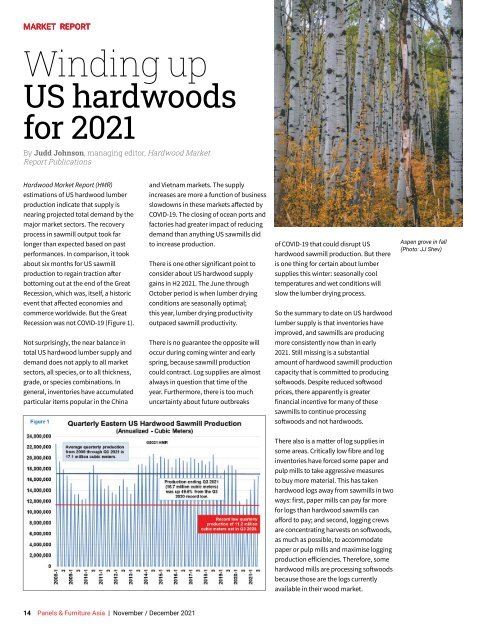Panels & Furniture Asia November/December 2021
Panels & Furniture Asia (PFA) is a leading regional trade magazine dedicated to the woodbased panel, furniture and flooring processing industry. Published bi-monthly since 2000, PFA delivers authentic journalism to cover the latest news, technology, machinery, projects, products and trade events throughout the sector. With a hardcopy and digital readership comprising manufacturers, designers and specifiers, among others, PFA is the platform of choice for connecting brands across the global woodworking landscape.
Panels & Furniture Asia (PFA) is a leading regional trade magazine dedicated to the woodbased panel, furniture and flooring processing industry. Published bi-monthly since 2000, PFA delivers authentic journalism to cover the latest news, technology, machinery, projects, products and trade events throughout the sector. With a hardcopy and digital readership comprising manufacturers, designers and specifiers, among others, PFA is the platform of choice for connecting brands across the global woodworking landscape.
You also want an ePaper? Increase the reach of your titles
YUMPU automatically turns print PDFs into web optimized ePapers that Google loves.
MARKET REPORT<br />
Winding up<br />
US hardwoods<br />
for <strong>2021</strong><br />
By Judd Johnson, managing editor, Hardwood Market<br />
Report Publications<br />
Hardwood Market Report (HMR)<br />
estimations of US hardwood lumber<br />
production indicate that supply is<br />
nearing projected total demand by the<br />
major market sectors. The recovery<br />
process in sawmill output took far<br />
longer than expected based on past<br />
performances. In comparison, it took<br />
about six months for US sawmill<br />
production to regain traction after<br />
bottoming out at the end of the Great<br />
Recession, which was, itself, a historic<br />
event that affected economies and<br />
commerce worldwide. But the Great<br />
Recession was not COVID-19 (Figure 1).<br />
Not surprisingly, the near balance in<br />
total US hardwood lumber supply and<br />
demand does not apply to all market<br />
sectors, all species, or to all thickness,<br />
grade, or species combinations. In<br />
general, inventories have accumulated<br />
particular items popular in the China<br />
and Vietnam markets. The supply<br />
increases are more a function of business<br />
slowdowns in these markets affected by<br />
COVID-19. The closing of ocean ports and<br />
factories had greater impact of reducing<br />
demand than anything US sawmills did<br />
to increase production.<br />
There is one other significant point to<br />
consider about US hardwood supply<br />
gains in H2 <strong>2021</strong>. The June through<br />
October period is when lumber drying<br />
conditions are seasonally optimal;<br />
this year, lumber drying productivity<br />
outpaced sawmill productivity.<br />
There is no guarantee the opposite will<br />
occur during coming winter and early<br />
spring, because sawmill production<br />
could contract. Log supplies are almost<br />
always in question that time of the<br />
year. Furthermore, there is too much<br />
uncertainty about future outbreaks<br />
of COVID-19 that could disrupt US<br />
hardwood sawmill production. But there<br />
is one thing for certain about lumber<br />
supplies this winter: seasonally cool<br />
temperatures and wet conditions will<br />
slow the lumber drying process.<br />
So the summary to date on US hardwood<br />
lumber supply is that inventories have<br />
improved, and sawmills are producing<br />
more consistently now than in early<br />
<strong>2021</strong>. Still missing is a substantial<br />
amount of hardwood sawmill production<br />
capacity that is committed to producing<br />
softwoods. Despite reduced softwood<br />
prices, there apparently is greater<br />
financial incentive for many of these<br />
sawmills to continue processing<br />
softwoods and not hardwoods.<br />
Aspen grove in fall<br />
(Photo: JJ Shev)<br />
There also is a matter of log supplies in<br />
some areas. Critically low fibre and log<br />
inventories have forced some paper and<br />
pulp mills to take aggressive measures<br />
to buy more material. This has taken<br />
hardwood logs away from sawmills in two<br />
ways: first, paper mills can pay far more<br />
for logs than hardwood sawmills can<br />
afford to pay; and second, logging crews<br />
are concentrating harvests on softwoods,<br />
as much as possible, to accommodate<br />
paper or pulp mills and maximise logging<br />
production efficiencies. Therefore, some<br />
hardwood mills are processing softwoods<br />
because those are the logs currently<br />
available in their wood market.<br />
14 <strong>Panels</strong> & <strong>Furniture</strong> <strong>Asia</strong> | <strong>November</strong> / <strong>December</strong> <strong>2021</strong>


















